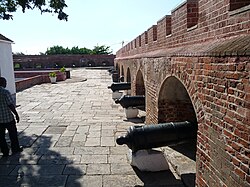History
In 1654, Jamaica was under Spanish control and Spain was at war with England. Oliver Cromwell, Lord Protector of England, sent an expedition to invade the Spanish island Hispaniola. When the expedition failed, its leaders did not want to return home in shame. They turned their attention to capturing Jamaica, which was poorly defended. The buccaneer Henry Morgan was a member of the invading force led by William Penn and Venables. By May 1655, the English gained control of the island, and began construction of a fortified stronghold to defend their new acquisition. The fort was completed in 1655 and was the first of six forts to be built and manned by a garrison in Jamaica. It was initially referred to as Passage Fort [2] and after it was finished it was given the name "Fort Cromwell" in honour of the patron of the expedition and leader of the Commonwealth at the time. However, it received its present name after the restoration of the monarchy under Charles II. [1]
By 1667 it had 36 guns while in 1765 it had 104 guns and a garrison of 500 men. [1] It was damaged by both the 1692 Jamaica earthquake and the 1907 Kingston earthquake, which later resulted in the tilting of the Giddy House, now a minor tourist attraction.
The other fort guarding Kingston Harbor is now the Fort Augusta Adult Correctional Centre
This page is based on this
Wikipedia article Text is available under the
CC BY-SA 4.0 license; additional terms may apply.
Images, videos and audio are available under their respective licenses.


